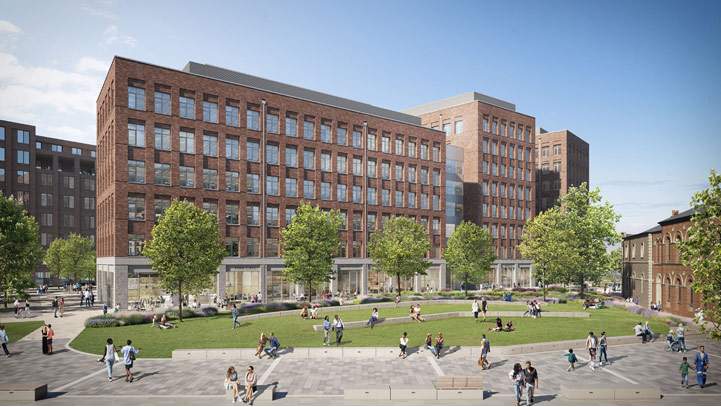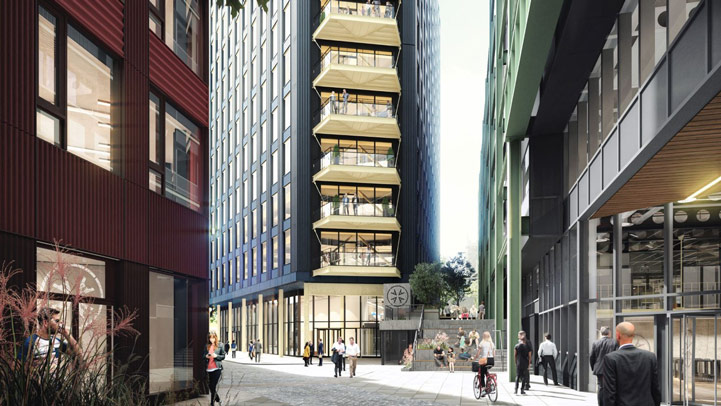To what extent is the current supply level and development pipeline enough to satisfy potential demand in 2023?
With a continuing flight-to-quality amongst occupiers across the UK regions, a key question for real estate professionals has been whether there is sufficient supply of best-in-class buildings to meet the demand levels in the sector.
One early assumption of the move to hybrid working was that occupiers will be downsizing in order to account for reduced occupancy levels. Conservative estimates predicted a potential 20–30% reduction, with employees expected to spend an average of three days a week in the workplace.
Issues surrounding increased occupancy levels on certain days of the week and business expansions have produced a very different story. Furthermore, the latest office occupancy data shows that the number of employees returning to the office has reached a new high since the pandemic. Savills latest research has found that there was a marginal increase in the total space occupied in 2021 and 2022. This analysis compared newly leased space over 10,000 sq ft with the size of the office space where the tenant previously occupied in the city to produce a net square footage of space occupied. This does not include tenants that have completely shut down offices in individual markets.
Considering specific business sectors, some sectors have shown a trend towards an increase in office space occupied during this period. In spite of the recent press coverage surrounding redundancies in Big Tech organisations, particularly in London, regional occupiers in the ‘TMT‘ sector have increased the sq ft of total office space occupied by 64% through office moves in 2021 and 2022, when compared to the size of the space where they were previously located. This includes companies such as Cloud Imperium in Manchester, Wildstar Film Studios in Bristol and FNZ in Edinburgh. Whilst some other sectors, such as ‘Professional’ have downsized (-21%), the overall trend is a positive one.
The data also shows that in many cases occupiers who are downsizing are willing to pay an average of 54% more rent per sq ft in order to secure a higher quality of space. 46% of occupiers analysed, actually increased their total rent roll by an average of 20% even though the space they were occupying decreased.
In light of the current market conditions, the key question facing the UK regions is, ‘how will prime availability levels respond to these dynamics in 2023 and beyond?‘
With resilient Grade A demand and limited supply, this is likely to put further upward rental pressure in all of the Big 6 regional office markets over the next five years
Clare Bailey, Director, Commercial Research
From a rental perspective, the continuing flight-to-quality and falling availability of prime space is likely to put further upward rental pressure across the regions. Five of the Big 6 markets recorded prime rental increases in 2022, with Bristol and Leeds achieving 12% and 6% growth, respectively. Savills latest forecasts are predicting further increases in prime rents in Birmingham, Bristol, Edinburgh, Leeds and Manchester in 2023. By 2025, prime rents could be as high as £45 per sq ft in Bristol, with all of the regional Big 6 markets expecting to surpass the £40 per sq ft in 2025.
Equally, away from the top achieved rents, the flight-to-quality has also served to increase the average Grade A rents across the Big 6 markets. 2022 was the highest average Grade A rent on record at £31.51 per sq ft. This represented an increase of 19% over the last five years and a significant increase of 42% over the last ten years.
We remain optimistic about the performance of the regional office market in 2023 in spite of the economic challenges the UK currently faces. The market proved its resilience through a much worse economic period in 2020/21, in some cases delivering record prime rent levels. The factors that drove this resilience are still in place, specifically an under-supply of prime space, a contracting development pipeline, strong demand for best-in-class space and further centralisation into city centres. As such, the current prime A availability levels means that supply levels are likely to remain constrained in the coming years.
In forecasting demand for next year, using five-year average annual Grade A take-up, the data shows that supply may not even be sufficient to meet demand in five of the Big 6 markets next year, with Manchester only having enough prime supply for 1.1 years of average demand.
The situation is particularly apparent in the Scottish markets, with no developments due to complete in 2023 and just 150,000 sq ft of prime space available across the two markets. Unless tenant-listed space is returned to the market, the current supply levels in these markets is only enough to satisfy six months of demand.
Filling the gap: the role of refurbishments?
In order to satisfy this demand, and against a backdrop of limited new supply in some of the Big 6 cities, refurbishments will be a key focus of the UK regional office market in the years ahead for both landlords and occupiers.
With such limited new build prime supply available, it is likely that comprehensive refurbishments may fill the gap to provide a viable alternative to occupiers in 2023 and beyond. Examples include Lucent at 50 Bothwell Street in Glasgow, which will provide 90,000 sq ft office space for the market, and 10 Brindleyplace in Birmingham which provides 210,000 sq ft of refurbished space into markets where the development pipeline is extremely thin between 2023 and 2025.
The office market is starting to see a ‘new generation‘ of refurbishments which offer a much higher quality product than ever before, with ‘back to frame‘ schemes now becoming increasingly interchangeable with new build stock.
On this basis, Savills expects that the gap between prime rents and top refurb rents will continue to contract across the Big 6 markets next year as occupiers look to refurbishments to potentially assist in reaching internal sustainability and wider ESG targets.
Redefining Grade A: the emergence of prime stock
For many years the expression ‘Grade A‘ has been used as a broad definition of the best offices within a particular market. Crudely this was characterised by a combination of an office being in an excellent location and possessing a specification in accordance with the BCO Guide – more often than not air conditioning, a raised floor and a suspended ceiling. Given the very significant changes in office specification and particularly amenity provision and ESG credentials, Savills have concluded the need for a more contemporary classification of this new breed of highest-quality offices.
As businesses seek to demand ‘best in class‘ the traditional Grade A definition is no longer fit for purpose. A new categorisation of office, defined as prime, has therefore been introduced to capture those buildings that have not just the highest quality specification but also respond to the ever-growing need for occupier amenity and far greater levels of sustainability than ever.
Case Studies: New generation Prime space across the regional markets
Innovation, ESG, Amenity
.jpg)
Case Study: 10 Brindleyplace, Birmingham
Investment in 10 Brindleyplace has gone way beyond terminology normally associated with refurbishment and reflects a level of re-engineering now required for future focussed refurbishment.
Reflecting future government and occupier targets, construction has enabled the building to meet increasingly stringent sustainability and work environment aspirations.
The all-electric powered building has raised the bar with a specification that has secured BREEAM Excellent, EPC A, Wired scored platinum and Fitwell accreditations. It not only focuses on the working environment but also wider amenity to include a shared roof garden, numerous dedicated terraces, a fitness area and Birmingham’s first Bouldering wall.

Case Study: Aire Park, Leeds
Vastint UK is a values-led organisation as well as a commercial one, specialising in creating large-scale urban developments which balance working, living and leisure activities; in sites which are connected to their history and local context. They take inspiration from best practices around the world, challenging specialists to find new creative ways of reimagining and reinvigorating how to design urban landscapes.
Vastint acquired Aire Park in 2016. Forming part of a wider mixed-use development, the first phase of 207,000 sq ft office space will add to what is set to become the largest new city centre green space in the UK. Cartwright Pickard is the architect behind the building, with structural designs aiming to maximise its thermal performance to help the building achieve a BREEAM Excellent rating.

Case Study: Assembly C, Bristol
AXA/Bell Hammer’s approach to the development at Assembly Building C combines a prime waterfront location with rooftop views and a genuine well-being focus. It is the only building in the city with private roof terraces for office occupiers on every floor of the building. Add this to the 5,000 sq ft communal roof terrace at the top of the development and it offers a truly unique product.
In terms of ESG, it is also market leading with BREEAM ‘Excellent, Well ‘Platinum’ certified and has a target EPC rating of A.
By combining this superior amenity, location and sustainability credentials, this has established assembly as a prime space within the market which has been reflected by the rental levels that have been achieved to date.
